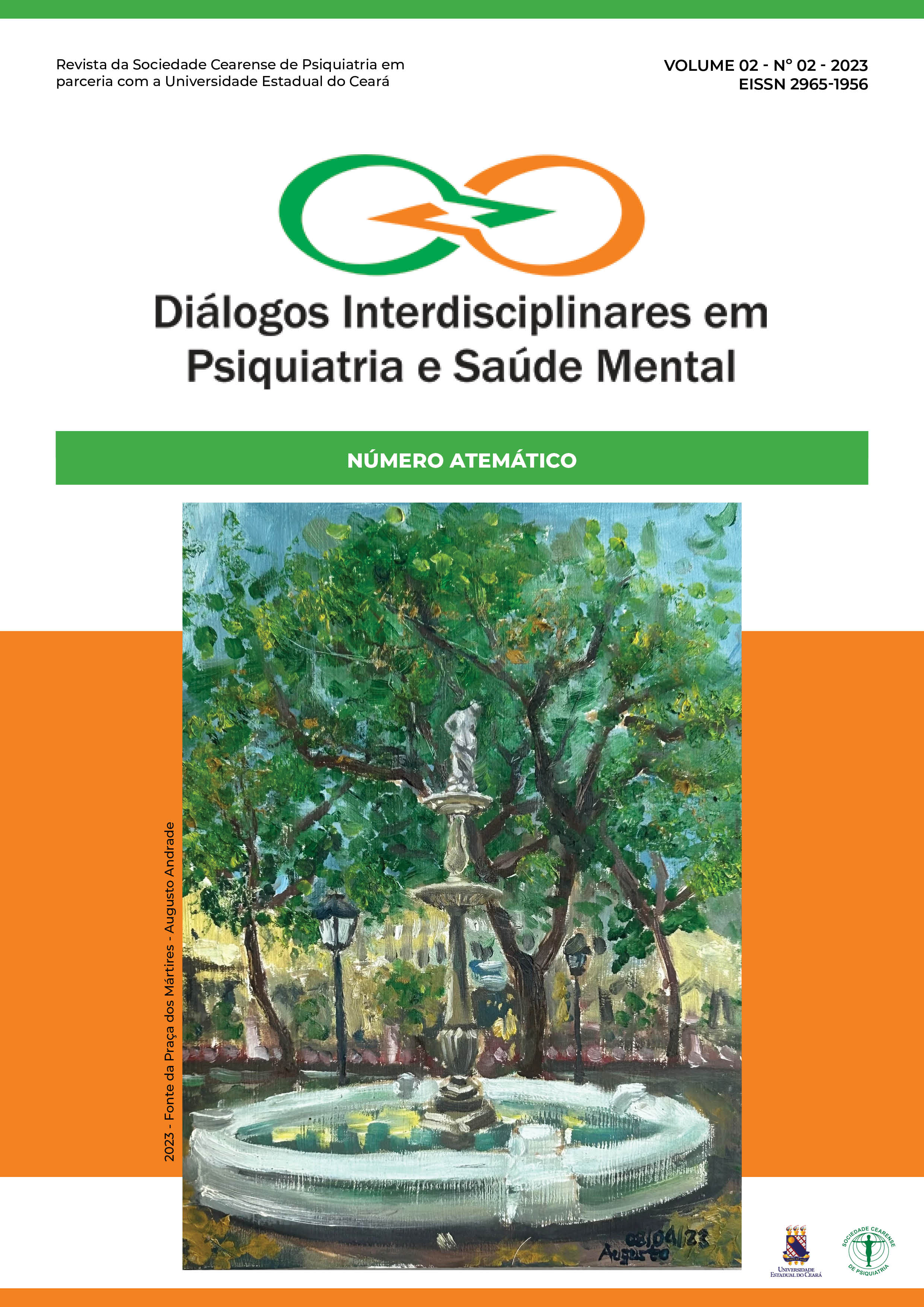Tratamientos para la locura y la historia de los antipsicóticos
DOI:
https://doi.org/10.59487/2965-1956-2-10915Palabras clave:
Trastornos Psicóticos, Historia de la medicina, Antipsicóticos, Terapias Somaticas PsiquiatricasResumen
Objetivo: Revisar la historia de las intervenciones sobre la locura, centrándonos en la Edad Antigua, Edad Media, Edad Moderna y Edad Contemporánea, y presentarla como un texto de introducción al estudio del tratamiento de las psicosis. Metodología: Revisión narrativa de literatura histórica no sistemática sobre el tratamiento de la psicosis. Desarrollo: La locura, interpretada en este texto como psicosis, ha sido estudiada desde la Edad Antigua, inicialmente interpretada como un fenómeno de influencia divina, seguida de la teoría de los humores, que se prolongó desde la época clásica griega hasta la Ilustración, tras la cual la moral y de carácter naturaleza de asilo. A partir del siglo XX se iniciaron las terapias biológicas, como la terapia convulsiva, y, en la segunda mitad del siglo, aparecieron los primeros antipsicóticos. Así, a lo largo de la historia se han formulado varias explicaciones y tratamientos. En este texto abordamos parte de estas teorías y terapias, desde la antigüedad hasta la contemporaneidad, con excepción de las diversas modalidades psicoterapéuticas. Consideraciones finales: Aunque no todo el conocimiento se sostiene a lo largo de los años, parte se mantiene y resignifica.
Descargas
Citas
Dalgalarrondo P. Psicopatologia e semiologia dos transtornos mentais. 3a ed. Porto Alegre: Artmed; 2019.
Rezende JM, Moraes VA, Perini GE. Seara de Asclépio: uma visão diacrônica da medicina. 2nd ed. Goiânia: Editora UFG; 2018.
Reinaldo AMS, Santos RLF. Religião e transtornos mentais na perspectiva de profissionais de saúde, pacientes psiquiátricos e seus familiares. Saúde debate [Internet]. 2016;40(110):162–171. Available from: https://doi.org/10.1590/0103-1104201611012
Rosen G. The Mentally Ill and the Community in Western and Central Europe During the Late Middle Ages and the Renaissance. Journal of the History of Medicine and Allied Sciences. 1964;19(4):377-388
Grant M. Dietetic responses in Galen to madness. Classical Bulletin. 2000;76:61-70.
Aucoin M, LaChance L, Cooley K, et al. Diet and Psychosis: A Scoping Review. Neuropsychobiology. 2020;79(1):20-42.
Laukkanen T, Laukkanen J, Kunustsor S. Sauna Bathing and Risk of Psychotic Disorders: A Prospective Cohort Study. Medicine Principals and Practice. 2018;27(6):562-569
Van Os J, Kenis G, Rutten B. The environment and schizophrenia. Nature. 2010;468(7321):203-212
Pessotti I. Sobre a teoria da loucura no século XX. Temas psicol.[Internet]. 2006 [citado 2023 Maio 15];14(2):113-123. Disponível em: http://pepsic.bvsalud.org/scielo.php?script=sci_arttext&pid=S1413-389X2006000200002 &lng=pt.
Amarante P. Saúde mental, políticas e instituições: programa de educação a distância. Rio de Janeiro: Fiotec/Fiocruz EAD/Fiocruz; 2003.
Conselho Federal de Psicologia, Mecanismo Nacional de Prevenção e Combate à Tortura, Procuradoria Federal dos Direitos do Cidadão, et al. Relatório da Inspeção Nacional em Comunidades Terapêuticas [Internet]. Brasília: CFP; 2018 [cited 2023 May 15]. Available from: https://site.cfp.org.br/publicacao/relatorio-da-inspecao-nacional-em-comunidades-terapeuticas/
Austin SC, Stolley PD, Lasky T. The history of malariotherapy for neurosyphilis: Modern parallels. JAMA. 1992;268(4):516-519.
Tierney J. Egas Moniz and the Origins of Psychosurgery: A Review Commemorating the 50th Anniversary of Moniz's Nobel Prize. Journal of the History of the Neurosciences. 2010;9(1):22-36.
Mahoney D, Green A. Psychosurgery: History of the Neurosurgical Management of Psychiatric Disorders. World Neurosurgery. 2020;137:327-334.
Fink M. Convulsive therapy: a review of the first 55 years. Journal of Affective Disorders. 2001;63(1):1-15
Baran B, Bitter I, Ungvari G, et al. The birth of convulsive therapy revisited: A reappraisal of László Meduna's first cohort of patients. Journal of Affective Disorders. 2012;136(3):1179-1182.
Delay J, Deniker P, Harl J. Utilisation en thérapeutique psychiatrique d'une phénothiazine d'action centrale élective. Annales médico-psychologiques. 1952;110(1):112-117.
Ban T. Fifty years chlorpromazine: a historical perspective. Neuropsychiatric disease and treatment. 2007;3(4):495-500.
Crow T. Molecular pathology of schizophrenia: more than one disease process?. Britsh Medical Journal. 1980;280(6207):66-68.
Hirsch L, Yang J, Bresee L, et al. Second-Generation Antipsychotics and Metabolic Side Effects: A Systematic Review of Population-Based Studies. Drug Safety. 2017;40(9):771-781.
Preda A, Shapiro B. A safety evaluation of aripiprazole in the treatment of schizophrenia. Expert Opinion on Drug Safety. 2020;19(12):1529-1538.
Azorin JM, Simon N. Dopamine Receptor Partial Agonists for the Treatment of Bipolar Disorder. Drugs. 2019;79(15):1657-1677.
Braslow J, Marder S. History of Psychopharmacology. Annual review of clinical psychology. 2019;7(15):25-50
Kane J, Honigfeld G, Singer J, et al. Clozapine in treatment-resistant schizophrenics. Psychopharmacology Bulletin. 1988;24(1):62-67.
Tailape H, Mittendorfer-Rutz E, Alexanderson K, et al. Antipsychotics and mortality in a nationwide cohort of 29,823 patients with schizophrenia. Schizophrenia Research. 2018;197:274-280.
Descargas
Publicado
Cómo citar
Número
Sección
Licencia
Derechos de autor 2023 Joel Porfirio Pinto, Danielle Macêdo Gaspar, Natália Sousa Cavalcante Barroso

Esta obra está bajo una licencia internacional Creative Commons Atribución 4.0.










